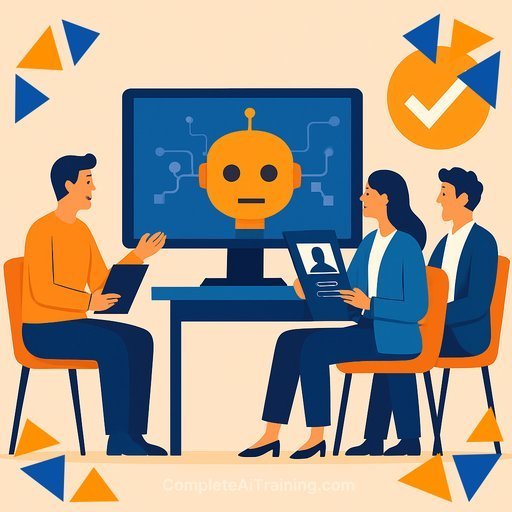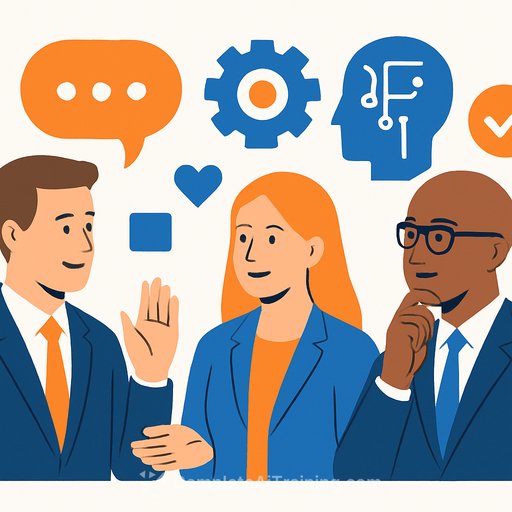AI in Human Resources: Transforming the Future of Workforce Management
HR is shifting from intuition-heavy work to a discipline fueled by data and automation. With AI embedded across workflows, teams can attract, develop, and retain talent with more speed and accuracy. This isn't a tech add-on-it's a smarter way to manage people and outcomes.
The Rise of AI in HR
Adoption has accelerated as HR teams seek efficiency, better decisions, and a more personalized employee experience. AI now supports everything from sourcing and screening to sentiment analysis and retention. The result: less manual work, more informed decisions, and a clearer view of workforce trends.
With predictive analytics and intelligent automation, HR can act before problems surface. Teams can spot skill gaps, forecast needs, and prioritize interventions that move the business forward.
Key Applications of AI for HR
- Recruitment and talent acquisition: Screen resumes at scale, match on skills and experience, and reduce bias through consistent, auditable criteria. Hiring cycles shorten while quality improves.
- Employee engagement and retention: Sentiment analysis and digital listening reveal morale shifts early, so managers can respond with targeted actions.
- Learning and development: Recommendation engines build personalized learning paths that align to role, proficiency, and goals-speeding up skill growth.
- Performance management: Continuous analytics inform coaching, fairer evaluations, and clearer alignment between goals and results.
AI and HR now operate as one system-linking processes, data, and decisions into a consistent talent engine.
From Automation to Intelligence: The Strategic Impact
Early wins came from automating administrative tasks. The next step is intelligence: using models to forecast hiring needs, map leadership potential, and signal organizational health.
Example: A financial services firm combines HR data with productivity and innovation metrics to see which teams create the most value. Predictive attrition alerts prompt timely retention actions-protecting critical roles and knowledge.
With clear governance and ethical standards, AI improves transparency, fairness, and inclusion across the workforce.
Overcoming Challenges in AI Adoption
Success depends on clean data, bias mitigation, and strong change management. HR, IT, and business leaders must work together to align AI use with policies, regulation, and culture.
Experienced partners can accelerate progress with proven implementation methods-from use-case selection and model development to integration with existing HR tech.
How The Hackett Group® Is Enabling AI-Driven HR Transformation
The Hackett Group® helps enterprises unlock measurable HR outcomes with specialized AI consulting services. Its AI XPLR™ platform identifies, quantifies, and prioritizes high-ROI opportunities across HR-using Digital World Class® benchmarks to expose performance gaps and simulate solution scenarios.
ZBrain™ operationalizes models securely inside the enterprise. By combining process intelligence with model orchestration, HR teams can move from insight to action with confidence-across workforce planning, talent management, and employee experience.
Actionable Steps for HR Leaders
- Start with business outcomes: Define precise goals (e.g., reduce time-to-fill by 25%, improve first-year retention, cut administrative hours per HRBP).
- Build data readiness: Standardize job architectures, clean historical records, and integrate HRIS, ATS, LMS, and engagement data for analysis.
- Prioritize ethical AI: Use documented guardrails for explainability, bias testing, and monitoring. The NIST AI Risk Management Framework is a helpful reference.
- Upskill the workforce: Raise AI literacy for HRBPs, recruiters, and managers so they can interpret insights and adjust processes. For role-based learning paths, see Complete AI Training: Courses by Job.
- Collaborate across functions: Coordinate with IT, finance, and operations to ensure security, scalability, and measurable ROI.
The Future of AI and HR: Human-Centric Intelligence
AI will not replace the human side of HR-it frees it. Assistants, NLP, and generative tools handle analysis and workflow so HR professionals can focus on empathy, strategy, and coaching.
The best HR teams will operate like experience architects, crafting personalized journeys that support performance, inclusion, and well-being.
Conclusion: Turning AI into a Catalyst for Human-Centered Transformation
AI in HR delivers more than efficiency-it improves decisions, creates better employee experiences, and fuels continuous improvement. With the right strategy, governance, and tooling, HR becomes a strategic engine for growth and adaptability.
By partnering with an experienced AI consulting company like The Hackett Group®, organizations gain access to proven services, AI XPLR™, and ZBrain™-turning plans into measurable impact. For additional guidance on responsible adoption, explore insights from SHRM on HR technology.
Your membership also unlocks:






